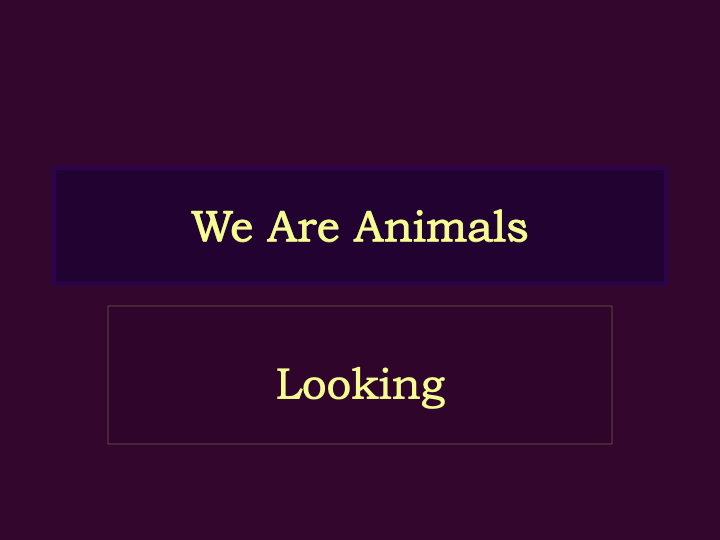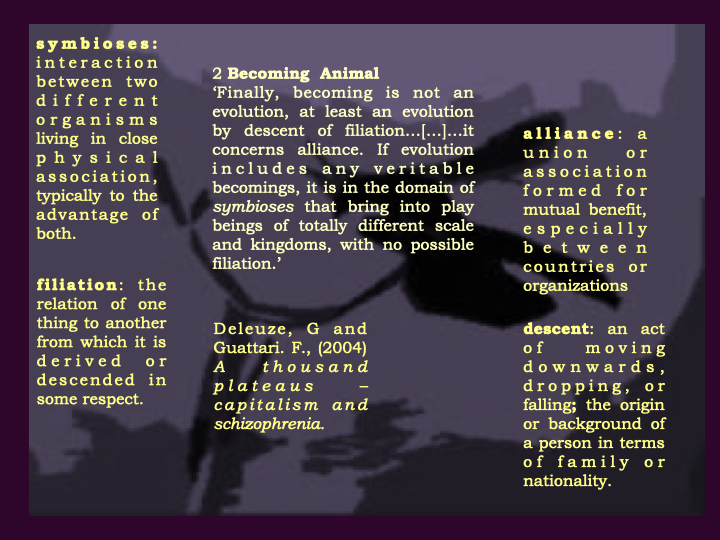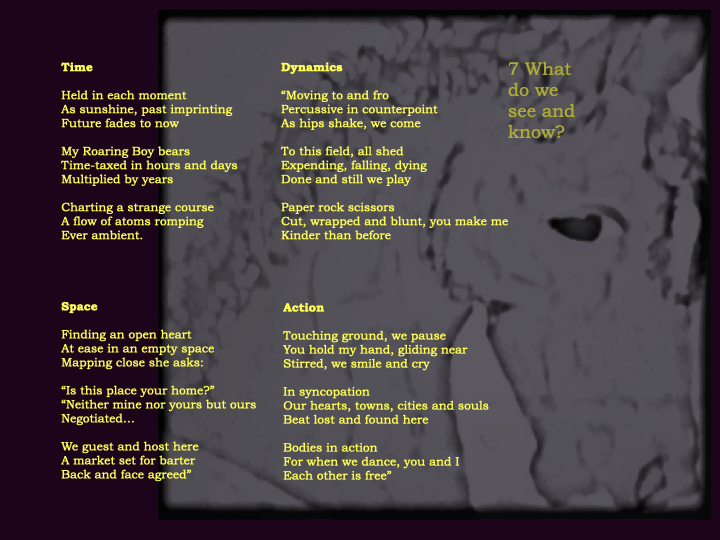Tim Taylor

Slide 1 – I decided that I’d work with the colours purple and yellow. The background would start dark and run to light by the final slide. I did this because I liked the idea of change but keeping with a particular palette.

Slide 2 – References A Thousand Plateaus – Capitalism and Schizophrenia (Deleuze, G and Guattari, F: 2nd ed. 2004). This page displays five sections of citation from Webster’s Dictionary. The terms explained have been selected as they are referenced in a chapter of the book, exploring the concept of ‘Becoming Animal’. My understanding derived has to do with idea of entities that form association without needing – necessarily – to have a conventionally justifiable reason for forming a bond, be that a bond of the familial, of the socially constructed, of the territorially aligned or otherwise. The background depicts an image of a wasp and an orchid. There is a fascinating section in the book that explores a kind of enfolding association between these two living things.

Slide 3 – The artists Dutton and Swindells work with the idea of ‘becoming animal’ as a concept that need not be seen as having to do with an end in itself but rather one of perpetual change.

Slide 4 – Has to do with evolution; of how animals develop particular sensory ability according to the circumstances of their need to survive.

Slide 5 – Explores ideas of the other, of the abiding differences between animals and humans and of the folly of humankind assuming superiority over animals.

Slide 6 – Shows four verses of three haikus in each. The verses, taken as a whole, speak of an encounter between two living entities. They also explore the idea of the self and other being embodied within a single entity. The image is of me, dressed in costume as a kind of Spanish matriarch – I rather thought of the look as capturing the fantasy of the character of Anna Madrigal from Armistead Maupin’s Tales of The City. I named the verse collection Animals where the look is clandestine as the idea of seeing and knowing that is hidden seems emancipatory.

Slide 7 – Repeats the same four verses as slide 6. This time, the image is of a drawing of a horse that I made as a child. I recall my father commenting that the horse looked like me.

Slide 8 – Is a short description of an occurrence my mother witnessed. It tells of ducks by a riverbank observing gulls overhead. I was struck by the idea of my mother watching the ducks watch the gulls and how, in a way, this had some sense of subtle significance. The image is of lavender growing near the river described. Separately, a duck, looking upwards.

Slide 9 – Shows a print of a study by Picasso of a young woman and a monkey in each other’s thrall and with a third figure looking on. I have teamed it with a text, unrelated to Picasso’s pictures as such, that speaks of the reductive nature of anthropomorphism and its limiting effect on the encounter between humans and animals when set against a potential for interaction of an altogether richer form.

Slide 10 – Shows a quote drawn from the DRS website, citing the composer Jelly Roll Morton speaking about his experience of the cultural life of New Orleans. The image depicts a collection of the performers appearing in the choreographed work The Anamule Dance set to lyrics and music by Jelly Roll Morton (and with the same title).
I selected this combination of words and image for various reasons: because of the sound of the word Anamule; because of the ideas explored in the lyrics of Morton’s composition; because I performed in this work; because it is part of Jacky Lansley’s archive of choreographic work; because of Morton’s observation that people of disparate origins ‘could creep in close to other people’ through the sharing of music.






